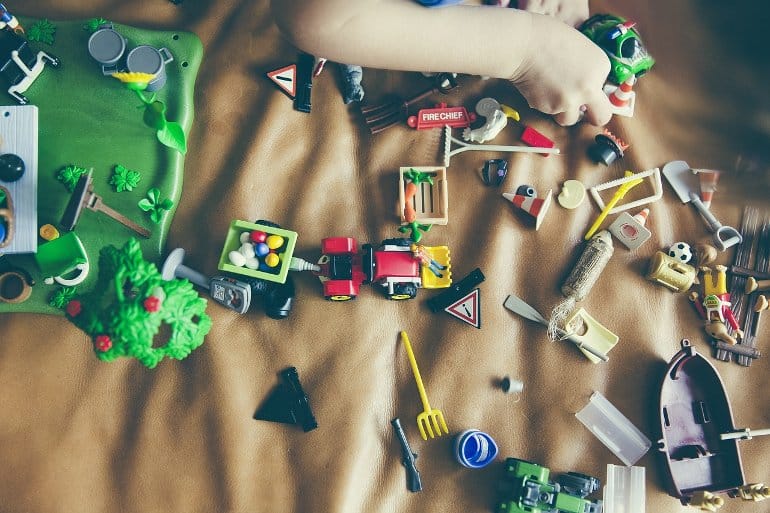Summary: Young children on the autism spectrum achieved joined attention similar to that of a neurotypical child when playing with their parents.
Source: Cell Press
For decades, autism research has relied on data collected during lab tasks or interviews with clinicians that are more constrained than the child’s day-to-day interactions with others.
A study published in the journal Current Biology on May 12 challenges the status quo by observing toddlers in more natural play settings.
By using a head-mounted camera to track kids’ eye movements as they played with toys, scientists observed that children with autism achieved joint attention—measured by time spent looking at the same toy at the same time as their parent—at typical levels.
To understand how children interact with social partners in more comfortable and natural settings, Julia Yurkovic-Harding, an autism researcher at Indiana University, was among the first to use a dual head-mounted eye-tracking method with children with autism to study social interactions between the children and their parents.
“The head-mounted eye tracking allows us to get precision in measuring their visual attention and manual action but allows us to let the children play more naturally,” says Yurkovic-Harding, the co-first author on the study.
Children who fall on the autism spectrum often have difficulty following a social partner’s eyes. This behavior, called gaze following, is a key part of how autism researchers tend to define joint attention.
However, researchers who use head-mounted eye tracking to study the development of typically developing children recently found that children don’t look at their parents’ faces very often when they’re playing with toys together.
This means that gaze following might not be an available cue for achieving joint attention in some more natural settings. Instead, typically developing children follow their parent’s hands, which are often touching or holding toys, as a way to know what their parent is looking at.
An assessment of data gathered during play sessions with a group of 50 kids aged 2 to 4 found that autistic children maintained joint attention at levels consistent with their neurotypical peers.


These results were exciting to Yurkovic-Harding. “Every time that you find something that’s typical and intact in children with autism, there’s this opportunity to explore,” she says. Additionally, the children with autism also used hand-following rather than gaze-following cues to follow their parent’s attention into joint attention.
Experiences, where a child focuses on an activity, like playing with a toy truck or building with blocks, together with a parent, are thought to support language development.
The current study found that parents of children with autism spectrum disorder named toys more frequently when they were in joint attention together compared to when they weren’t looking at the same toy.
Yurkovic-Harding and her team hope that by identifying times when kids with autism are able to play in more typical ways, adults can encourage autistic children to do more of these activities and allow for more chances for learning.
“We need to push to understand the everyday lives of individuals with autism, the social pressures that they face day to day, and the social context that they interact in so we can help them exist in the social world that’s all around us in a way that is comfortable and confident for them,” she says.
About this ASD research news
Author: Press Office
Source: Cell Press
Contact: Press Office – Cell Press
Image: The image is in the public domain
Original Research: Open access.
“Children with ASD Establish Joint Attention during Free-Flowing Toy Play without Face Looks” by Julia Yurkovic-Harding et al. Current Biology
Abstract
Children with ASD Establish Joint Attention during Free-Flowing Toy Play without Face Looks
Highlights
- ASD children engage in joint attention at frequent and typical levels during toy play
- Like TD dyads, ASD dyads follow hands (rather than eyes) to establish joint attention
- In both groups, parents name toys more frequently during moments of joint attention
- These results raise questions about the meaning of joint attention deficits in ASD
Summary
Children’s ability to share attention with another person (i.e., achieve joint attention) is critical for learning about their environments in general and supporting language and object word learning in particular.
While joint attention (JA) as it pertains to autism spectrum disorder (ASD) is often more narrowly operationalized as arising from eye gaze or explicit pointing cues alone, recent evidence demonstrates that JA in natural environments can be achieved more broadly through multiple other pathways beyond gaze and gestures.
Here, we use dual head-mounted eye tracking to examine pathways into and characteristics of JA episodes during free-flowing parent-child toy play, comparing children with ASD to typically developing (TD) children. Moments of JA were defined objectively as both the child’s and parent’s gaze directed to the same object at the same time.
Consistent with previous work in TD children, we found that both TD and ASD children rarely look at their parent’s face in this unstructured free play context. Nevertheless, both groups achieved similarly high rates of JA that far exceeded chance, suggesting the use of alternative pathways into JA. We characterize these alternate pathways, find they occur at similar levels across both groups, and achieve similar ends: namely, for both groups, targets of JA are named more frequently by parents in those moments than non-jointly attended objects.
These findings broaden the conceptualization of JA abilities and impairment in ASD and raise questions regarding the mechanistic role of the face-gaze-mediated JA pathway in ASD.
